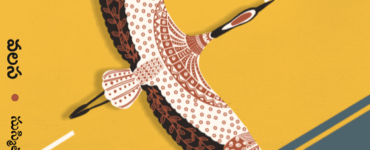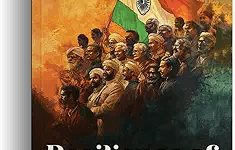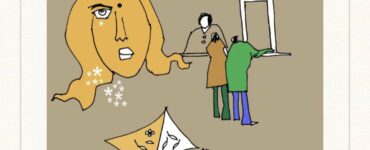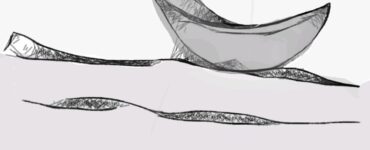What is the thin line that differentiates an art form from being a literary one? What should the theatre do as an art platform to motivate the viewers? What happens when an art form loses connection with its own past?
Drama as a genre in Kashmiri language has its roots in its folk theatrical form since the historical times. It continued to be so till the 1980s unlike its western counterpart which had been the favourite of the commoner in terms of entertainment. It was also able to transform into both literary and academic forms.
Tracing the origins and history of drama in Kashmir is like tracing of more of the theatrical performance than of the literary form. Theatre, which has been an integral part of Kashmiri culture since ancient times, became also a mode of communication in Kashmir.
In the earliest form of Kashmiri theatre, the unschooled and naive Lagun (‘imitation’) existed in a performatory tradition in the vernacular, i.e., old Kashmiri. Kashmir has seen many turbulent moments after 12th century in the form of invasions, attacks, floods, famines, raids, fires and epidemics from time to time and this had resulted in the loss of books, manuscripts and play-scripts. However, the folk form survived in all its manifestations through ‘Bhands’ of Kashmir in the shape of ‘Bhand-Pather’, and the legacy of a distinct original art form that closely falls into the category of theatre has established itself.
The golden age of drama in Kashmir lasted 1500 years- from the beginning of Christian era to the 15th century (Kaul, 1970 in Lal, 2009). Even during the Muslim rule, Bhands were the popular entertainers and they used to cross Pir Panchal range and perform in Jammu, Himachal, Punjab and other areas entertaining people through their humorous plays (Yasir, 2009). Bhands, like the music dance and drama of Kashmir have been performed usually on four occasions such as religious festivals, social occasions, agricultural festivals and in winter on first snow fall occasion. Once a year, in honour of the goddess Shiva Bhagvati, the Bhands perform a special ritualistic dance known as the chhok with great devotion and faith. The Bhands are Hindus converted to Islam who are very secular in their outlook and are an extremely simple, witty and practical people.
The plays of the Bhands are called pather, a word that seems to have derived from patra, a dramatic character. Bhand comes from the bhaana, a satirical and realistic drama, generally a monologue that is mentioned in Bharata’s Natya Shastra. The secular outlook of Bhands is reflected in their dynamic folk form that has incorporated many elements from the classical Sanskrit theatre as well as from other traditional folk forms of India.
The Bhands of Kashmir which have different ‘pathers’(folk plays) reflect various themes of Kashmiri theatre. Dard Pather portrays the picture of Kashmir under the ‘Dards’, a symbol for Afghan governing elite. Gosaine Pather focuses on the historical reality that Kashmir has been abode of saints, sadhus, peers and sufis and searches for the ultimate reality and universal brotherhood which have been the dominant factors over the centuries. Buhir Pather and Bata Pather portray the characteristics of the most prominent Pandit community as it lived centuries back. Shikargah Pather, a dance drama, which only uses masks, is named after the great sanctuary- Shikargah laid out by the Mughals when they ruled Kashmir. Raaze Pather brings back the bad memories of the Afghan rule in Kashmir, by depicting the lavish styles of the kings and their courtiers, downtrodden oppressed state of masses, rampant corruption and the high handedness of the officials. Aarmen Pather depicts the lifestyle of aarem (vegetable farmers) section of the society. Waatal Pather, one of the oldest Pathers performed today, depicts the lifestyle of the Waatal tribe. Hanz-Pather is about Fishermen, Chakwal-Pather is about Chakdars, Bakarwal Pather depicts the life of a backward class called Bakarwals, a shepherd tribe from hilly areas of the state and Angrez Pather depicts the English oppression of the Kashmiris. (Fayaz, 2008)
The Bhands are found in almost all of the districts of Kashmir and performances are a regular feature of life there. Some of the pathers have died and others are becoming rare. The form takes on new elements and continues to survive but rather precariously. The Bhands in their day to day living reflect their firm belief, in the faith of a unique fusion of Kashmiri Shaivism and Sufi traditions of the valley.
It was during the coronation time the King Maharaja Hari Singh invited the Elfred Theatre Company from Bombay to enact plays. The performances that followed and the visits by the Parsi Theatre Company raised new desires and hopes among the Kashmiri artists to revive their own theatre. Consequently many drama companies like Maharaja Drama Company, Saraswati Drama Club, Ram Natak Company, Kashmir Theatres Ltd and Amateur Drama Company came into being.
Besides the various folk originated Pathers of Bhands, as in other languages and states of India, here also flourished a tradition of devotional theatre that primarily aimed at conveying the message of truth and revealing the pleasure of leading a pious life. A repertoire of Hindu plays was always available to the performers and temple premises were the centers of these activities. Among the preserved manuscripts, Satich kahvet (‘Touchstone of Truth’) is the oldest accessible to readers. The author, Nandalal Kaul Nana (1877-1940), composed it on the life of Raja Harishchander, in rhymed dialogue with lyrical interludes. It was first performed in 1932 at Raghunath Mandir, Srinagar (Kaul, 1970 in Lal, 2009).
With the establishment of a body of writers named the Jammu and Kashmir Cultural Front (later Congress), theatre in Kashmir received serious attention. Several plays were composed and staged to strengthen the Front’s political viewpoint.
The progressive movement made its way into the literary movement of Kashmir, which naturally laid its impact on the emerging progressive theatre movement in Kashmir. In 1942 a play named Bat-e-Harh (quarrel of Rice – the most popular food of Kashmiris) was written by Prem Nath Pardesi. It was not allowed and later it was burned. With the advent of the popular Quit-Kashmir-Movement launched in 1946, “Kashmir Cultural Front” was formed in 1947 on Oct. 26 by the progressive nationalists of Kashmir under the inspiring leadership of G. M. Sadiq. It started street theatre movement. Under its banner, it staged play “Shaheed Sheervani” by Prem Nath Pardesi. The play “Kashmir Yeh Hai” was written by Mehmood Hashmi. to capitalise this national spirit and political conscience the artistes carried their plays to the remotest areas of Kashmir.
Sudhama Ji Koul wrote a play against the Tribal-Raid of PoK named “Kashmir Hamara Hai”, which was produced by the Community Theatre (at Shivalla Mandir) of Sudhar Samati Natak Vibagh, Chotta Bazar Srinagar. At the end of this decade Noor Mohamad Roshan wrote a bold socio-political satire – play “Chor Bazaar”. And the theatre of revolt also made its headway.
In 1950, a new repertory, Kala Kendra, emerged but after presenting two plays on the socialistic pattern, it returned to the old religious and romantic drama.
The founding of the Jammu and Kashmir Academy of Art , Culture and Languages (JKAACL) in 1958 initiated a new wave of enthusiasm for non- propagandist theatre, and several amateur clubs emerged in the capital, Srinagar and other towns. To rejuvenate, explore and strengthen the folk and traditional theatre of Kashmir i.e. the Bhand-Pather, Kashmir Bhagat Theatre Akingam, Anantnag was established in 1961 by Mohammad Subhan Bhagat. Nav Rang Dramatic Club (1964), Rangmanch (1967), and Royal Theatre (1967) were few of the popular theatre clubs of that time.
New experiments started in theatre movement of Kashmir, which gave birth to many plays like “YAHOO” were written and directed by R. K. Braroo, based on Bhand-Pather style, and produced by Himalaya Bhand Theatre, Wathora in 1966.
In 1974, eighteen repertories working in the valley set up an association called the Kashmir Theatre Federation under the guidance of Ali Mohammad Lone, Pran Kishore, Som Nath Pardesi, S.N. Zutshi, S.N.Sadhu, Bansi Mattoo, M. L. Kharoo, Moti Lal Kemmu and Makhanlal Saraf, Pushkar Bhan, Mohammad Subhan Baghat, D. N. Raina, G. N. Baba, Aziz Haroon, G. R. Santosh, D. N. Baqaya, A. K. Rehbar, Sajood Sailani, M. L. Saraf, Pran Kishore, H. N. Gurtoo, Virender Razdan, Piare Raina, Abdul Majeed Bhat, Noor Shah, Hafiza Kausar, Ratni Mattoo and Brij Kishori. This led to the glorious period in Kashmiri theatre. Drama Clubs of Nawakadal Girls’ College, S. P. College and M.A. Road Girls’ College also produced several plays, under Prof. Shamla Mufti (1928-2008) who aroused interest in theatre among college going students.
Kashmiri theatre started to get impacted badly with the onset of militancy in the state by mid 80’s and theatre came to a halt in the state completely. Several shrines, where the dramas were enacted were burnt down. In between, many unsuccessful attempts to infuse new energy to the theatre were made. The famous theatre platform, Tagore Hall was also burnt down in 90’s which acted as a major blow to the theatre activity of the state. Also due to prevailing militancy many actors and writers fled the state which again weakened the theatre activities further.
National School of Drama (NSD) in 2001 came under the supervision of M. K. Raina, a Kashmiri who had made it big on the national stage. A series of workshops that followed after his assuming the office,resulted in the re-emergence of groups, especially in rural areas. Su yi (‘He Will Come’,2005), adapted from Beckett’s Waiting for Godot by Arshid Mushtaq with two Bhand Pather clowns in the lead, attracted remarkable attention and was widely admired. The efforts of talented director Yasir Bashir Bhawani adequately enthused school and college students. In 2006, Sangeet Natak Academi and the JKAACL organized a folk festival in Srinagar, where old repertories of folk drama(Bhand) resurfaced with vigour (Kaul, 1970 in Lal, 2009).
*
Having traced the evolution of Kashmiri drama from its folk origins to the current form of the modern theatre a study of the luminaries who contributed to the growth and flourish of Kashmiri drama completes the study.
Aga Hashar Kashmiri (1875-1945) was one of the finest playwrights from Kashmir. Hashar developed taste for acting and writing plays for the companies during the days of his education. He had talent for writing poetry. Those days Parsi Theatre was the real patron of poets who could write both poetry and plays. As the atmosphere at home was not conducive for this activity, Agha Mahmood Hashar left for Bombay to try his luck in the field of playwriting. His career which can be divided into four phases started with adaptations of Shakespearean plays. He penned almost 30 plays on various themes. Agha introduced shorter songs and dialogues with idioms and poetic virtues in plays. The themes of his plays were so varied that he wrote on social, mythological and romantic aspects. He modelled his plays on the plays of great writers like Shakespeare, Henry Arthur Jones and W.T.Mancrift. Some of his plays aimed at addressing social evils and issues like prostitution.
Aga Hashar Kashmiri’s plays were seen with keenness, and were highly appreciated. He was the first Muslim playwright who has been awarded Gold Medal by Benaras Hindu University in recognition of his contribution to playwriting and Indian Theatre.
Pushkar Bhan (1923–2008) won many accolades as a distinctive writer and actor. Pushkar Bhan’s contributions to the genres of satire and humour in Kashmiri prose literature are immense. Not only did he originate and develop these genres in Kashmiri language (Oral and Written), he elevated these genres to the standards of universal excellence. His work, Machama, which won a Literary Award from the Sahitya Akademy, has been the source of 73 plays broadcasted from the Akashvani Radio’s Srinagar Channel. In this highly popular series, the main character role of Machama was played by Pushkar Bhan himself. When the first Television Broadcasting Channel was established in Srinagar, Pushkar Bhan gained immense popularity among viewers for his Laughter-Satire series, Doctor Zero. His play, Inklab, received high acclaim when it was televised by the Patna Channel. In addition to the Padamshree award in 1974, Pushkar won other notable awards like Sahitya Akademy Award in 1976.
Born in 1933 in Srinagar, Shri Moti Lal Kemmu (1933-2018) graduated from Jammu and Kahmir University in 1953. He received specialized training in Drama and theatre from Prof. C.C. Mehta at Baroda University from 1961 to 1964 under a Govt. of India scholarship. Kemmu made ‘band pather’ (Folk drama) his medium of narrative, where he combined the folk technique with the modern art form and used this synthesis to reflect the contemporary issues. Kemmu wrote in kashmiri language and had published four Drama collections. These are ‘three one act plays’, ‘Trinov’, ‘Lal be drayas lo-lare’ and ‘Tshay.'(Shadow).
Later he served in different capacities, in the cultural establishment of Govt. of Jammu and Kashmir from 1964 to 1991, during which period he also wrote, acted and directed plays in Kashmiri. He interlaced Lalitaditya’s tragedy with the difficulties being faced by a common man in today’s times. He depicted how faith is lost. When the king could just not do anything to save his soldiers, who while praising their master had termed his toe nails as the mirrors.
From history Kemmu moved to folk and wrote another drama woven through the thread of folk tale Hemaal Naegrai and Band Duhai. In Band Duhai the contemporary issue of militancy is tackled withsensitivity. This play is based on folk tale Aknandun. The drama depicts the helplessness of a common man is Kashmir.
He emerged as an important Kashmiri writer with his plays: Teen Asangati Aikanki (1968), Lal Drayas Lol Re (1972), Trunove (1970), Tshai (1973), Natak Truche (1980), Tota Tol Aina (1985). Several of his plays were also translated and produced in Hindi. Moti Lal Kemmu contributed greatly for the development of Kashmiri theatre. He was actively involved in preserving the age-old, dying folk theatre of Kashmir, by reorganising Bhand artists into regular groups. He developed more than 150 theatrical performances.
He was the founder of many theatre groups such as Abhinava Bharati, Kashmir Bhagat Theatre, Shahwali Lika Rang, Luka Theatre Bombay, National Bhand Theatre, Wathora etc. Shri Kemmu has also been writing well researched articles on folk theatre, music, dance and culture of Kashmir in Kashmiri, Urdu, Hindi and English, which have been published in prestigious journals. Shri Sidharth Kak’s documentary film The Bhands of Kashmir was produced under Shri Kemmu’s expert guidance.
Shri Kemmu worked as a Senior Fellow (Literature) of Govt. of India, Ministry of Human Resource Development, devoting his time to writing of plays and a book on folk theatre of Kashmir. He also organised a number of actor’s and playwrights’ workshops in Kashmir and made significant contribution to the promotion and dissemination of Kashmiri arts and culture. In recognition of his service to Kashmiri arts and literature, he has been honoured with several awards by the Government of Jammu and Kashmir, Rashtra Bhasa Prachar Samiti etc. He received the Sahitya Akademi award in 1982 for his contribution to Kashmiri literature as a playwright. He dedicated his entire life for the development f folk theatre in Kashmir.
M.K.Raina(1948-) is another great theatre actor and director. He graduated from National School of Drama and he directed a number of plays and serials on the TV. He worked with actors in a village 80 kms away from Srinagar and conducted several workshops.
Raina believes that the Bhand artistes speak a universal language. He believes that the traditional performers need to go abroad, and gain global recognition. He has been honoured with the Sanskriti Samman in 1980, the Sahitya Kala Parishad Award in 1981 the Best Director’s Award by West Bengal government in 1982 and the Best Director Award of Punjabi Akademi in 1987. The Government of Jammu and Kashmir felicitated him with the Sangeet Natak Award and Swarna Padak in 1996.
In the wake of the violent turmoil in Kashmir over the last two decades, the space for culture has shrunk, and the freedom to express and perform has been questioned. There has been no Bhand Pather performance and vital aspects of its performing culture are on the brink of disappearing. Many of the senior performers have passed away during this time. The younger generation of Bhands, unable to survive by pursuing their traditional vocation, are opting for alternative professions. However, there are still some pockets in the valley of Kashmir where Bhand families are striving to keep their performing art alive.
The tragic part of most of these folk theatre groups is the fact that they have turned to be the commercial performers of Bhand-Parties more than the traditional folk theatre groups by day and night defection in the run for money in the trading electronic-media world. This has badly diluted the artistic richness and traditional characteristics of our folk theatre. (Yasir)
Many other great playwrights, directors and theatre activists like Ashok Pandit, Jyothi Sarup, Atamjit Singh, Avatar K.Kaul, continued the tradition through their plays and serials on the T.V. Playwrights like Purva Naresh, and Arshad Mustaq are contributing their best to the (Kashmiri) Theatre through their thought provoking plays. They are trying to establish the forgotten culture of their land.
*









Very refreshing and informative. It is evident the writers have made lots of efforts in collecting information about the Drama in the Valley. Their macro pictures about the origin and development of Drama in Kashmiri comes handy for those who want to delve deep into the subject for academic research. The writers do deserve approbation for their scholarly efforts in bringing out this piece.
Thank you for your observations and appreciative comments sir. It really demands a lot of research and also patience not just from our side but from readers too. Appreciation from sincere readers like you will take the column a long way. This is certainly a learning experience in many ways!
Thank you sir for your response. Hope you both keep writing more and more such scholarly articles. All the very best.
Thank you. Actually writing these articles ia a huge learning experience too.